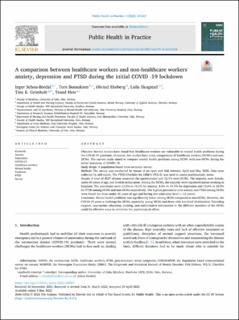| dc.contributor.author | Bredal, Inger Schou | |
| dc.contributor.author | Bonsaksen, Tore | |
| dc.contributor.author | Ekeberg, Øivind | |
| dc.contributor.author | Skogstad, Laila | |
| dc.contributor.author | Grimholt, Tine Kristin | |
| dc.contributor.author | Heir, Trond | |
| dc.date.accessioned | 2022-09-22T07:14:39Z | |
| dc.date.available | 2022-09-22T07:14:39Z | |
| dc.date.created | 2022-05-05T18:13:45Z | |
| dc.date.issued | 2022 | |
| dc.identifier.citation | Public Health in Practice. 2022, 3, 5. | en_US |
| dc.identifier.issn | 2666-5352 | |
| dc.identifier.uri | https://hdl.handle.net/11250/3020512 | |
| dc.description.abstract | Abstract
Objective
Several studies have found that Healthcare workers are vulnerable to mental health problems during the COVID-19 pandemic. However, few studies have made comparisons of healthcare workers (HCWs) and non-HCWs. The current study aimed to compare mental health problems among HCWs with non-HCWs during the initial lockdown of COVID 19.
Study design
A population-based cross-sectional survey.
Methods
The survey was conducted by means of an open web link between April and May 2020. Data were collected by self-report. The PTSD Checklist for DSM-5 (PCL-5) was used to assess posttraumatic stress.
Results
A total of 4527 citizens answered the questionnaire and 32.1% were HCWs. The majority were female, under 60 years of age, and lived in urban areas. Among the HCWs, the majority were registered nurses working in hospitals. The prevalence were 12.8% vs 19.1% for anxiety, 8.5% vs 14.5% for depression and 13.6% vs 20.9% for PTSD among HCWs and non-HCWs respectively. The highest prevalence's for anxiety and PTSD among HCWs were found for those under 40 years of age and having low education level (<12 years).
Conclusion
Mental health problems was significantly lower among HCWs compared to non-HCWs. However, the COVID-19 poses a challenge for HCWs, especially young HCWs and those with low level of education. Providing support, appropriate education, training, and authoritative information to the different members of the HCWs could be effective ways to minimize the psychological effect. | en_US |
| dc.language.iso | eng | en_US |
| dc.rights | Navngivelse 4.0 Internasjonal | * |
| dc.rights.uri | http://creativecommons.org/licenses/by/4.0/deed.no | * |
| dc.title | A comparison between healthcare workers and non-healthcare workers’ anxiety, depression and PTSD during the initial COVID -19 lockdown | en_US |
| dc.title.alternative | A comparison between healthcare workers and non-healthcare workers’ anxiety, depression and PTSD during the initial COVID -19 lockdown | en_US |
| dc.type | Peer reviewed | en_US |
| dc.type | Journal article | en_US |
| dc.description.version | publishedVersion | en_US |
| dc.rights.holder | The Author(s) | en_US |
| dc.source.volume | 3 | en_US |
| dc.source.journal | Public Health in Practice | en_US |
| dc.identifier.doi | 10.1016/j.puhip.2022.100267 | |
| dc.identifier.cristin | 2021929 | |
| dc.source.articlenumber | 100267 | en_US |
| cristin.ispublished | false | |
| cristin.fulltext | original | |
| cristin.qualitycode | 1 | |

